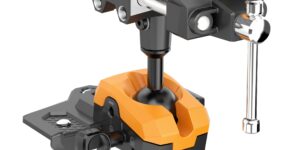Aluminum Welding: The Cost and Cure of Porosity
Porosity can be a problem in aluminum welding. Less than 3 percent by volume passes most industry codes and standards. But go over, and costs build, hour by $50 dollar hour.
Posted: December 5, 2011
THE COST
A welder lays down a gas-metal-arc bead on a thick-walled aluminum pressure vessel. Each seam requires a dozen weld passes. Once finished, the welder has deposited 30 ft of weld. According to NDE requirements, 1 ft must undergo spot X-Ray inspection. The pipe is wheeled into an X-ray booth, and it takes a half hour for the inspector to set up and take a shot.
Simple enough. Unfortunately, the inspector sees relatively severe porosity that is unacceptable by most codes. So, following the code, the inspector takes two more X-ray shots; setup and implementation take an hour. One more shot shows more unacceptable porosity. Under this circumstance, most codes tell inspectors to X-ray the entire weld. That’s 30 X-rays.
“Instead of putting about a half hour into inspection, the shop is now about 10 hours into it,” says Frank Armao, group leader, non-ferrous applications, Lincoln Electric Co. (Cleveland, Ohio). “They haven’t even repaired anything yet.”
Out of 30 inspections, five show porosity. The vessel is rolled back onto the floor. The areas of unacceptable weld are removed all the way through (to ensure no porosity remains) and re-welded. Each removal and re-weld takes about an hour, totaling five hours rework. The welder takes it back to the X-ray booth for five more shots. In the end, the entire ordeal takes 20 hours.
“At $50 an hour, that shop just spent $1,000 in labor alone,” Armao says, “and that’s just one repair cycle.
THE CURE
Aluminum weld porosity is caused by hydrogen. Molten aluminum has a high solubility for hydrogen; solid aluminum doesn’t, so the hydrogen tries to escape before cooling. If the weld pool cools too quickly, the hydrogen remains in the weld metal, causing porosity. This often calls for a slower cooling rate from higher welding currents, slower speeds, preheating, or a change in weld design. Multipass welds are ripe for trapping hydrogen.
Slower weld speed adds weld time, increasing costs; and alternative weldment design may not be an option. But regardless, the first goal should be to eliminate the sources of excessive hydrogen. Sources come from hydrocarbons and water vapor. Hydrocarbons come from oils and greases, often blamed on wire with drawing compound remaining. Note, however, that aluminum welding wire naturally develops an oxide coating when exposed to air. To test whether wire may have drawing compound on it, wipe the wire with a white rag, then put the rag under a black light. If it fluoresces, it’s grease; if it doesn”t, it’s oxide coating that GMAW can easily break.
Hydrocarbons also come from oily drive rolls or oily liner in the welding gun, an oily workpiece, even oil dropping from overhead cranes. (“I’ve heard them all,” Armao says.). Much of it comes from improper weld prep. Aluminum is shipped from the mill coated with a kerosene oil intended to make sheets easier to stack and unstack. It’s a hydrocarbon and so can cause porosity if not removed before welding.
To avoid water vapor, never use “wet” gas with a dewpoint more than minus 76 deg F (according to Armao, wet gas in cylinders is actually relatively rare). The vapor also comes from water-cooled guns. Before any visual evidence of a leak, a gun can leak enough moisture to give porosity.
In many welds, 20 ppm moisture in the weld area is enough. In humid weather, water flow in the gun should not be continuous. If water flows during idle periods, water vapor from the atmosphere may condense on the gas cup and other internal parts of the gun. Also, beware of hooking a water-cooled torch to a water spigot. Most municipal water supplies are cooler than the dewpoint of summer air, so condensation may occur.
Summer also can bring in what’s called “July Porosity.” Outside breezes disrupt the shielding gas, pulling in humid air. The water vapor lodges in the weld pool, resulting in porosity. Water also comes from condensation on the plate, condensation from an improperly sealed hose . . . “ indeed, any source of possible moisture. Humidity also limits appropriate places to store aluminum. “If you expose any aluminum alloy to air for more than a fraction of a second,” explains Armao, “the metal will develop a very thin, 40- to 50-atoms-thick oxide layer.”
GMA welding easily breaks down this layer, which, kept dry at room temperature, grows very slowly. Once wet, though, it forms a hydrated oxide, a chemical combination of water and aluminum oxide producing a gray stain or, if severe enough, a white powder. Welding over it may result in incomplete penetration (an insulator, oxides resist welding) and, of course, porosity.
“You hit this hydrated oxide with a 10,000 deg arc,” Armao says. “That’s more than enough temperature to break the water from the oxide on it.” Weld procedures must include degreasing and oxide removal, using solvents or chemicals to remove hydrocarbons, then using a stainless-steel wire brush to remove the aluminum oxide.
WORTH CORRECTING
Proper weld-prep might take a half hour total – $25 of labor, as opposed to up to perhaps $1,000 or more in inspection and rework costs. Proper storage and proper weld procedures upfront should be fundamental in a shop’s welding budget. If not, costs can spiral out of control.
The Lincoln Electric Company, 22800 Saint Clair Avenue, Cleveland, OH 44117-8542, 888-935-3876, frank_armao@lincolnelectric.com, www.lincolnelectric.com.









